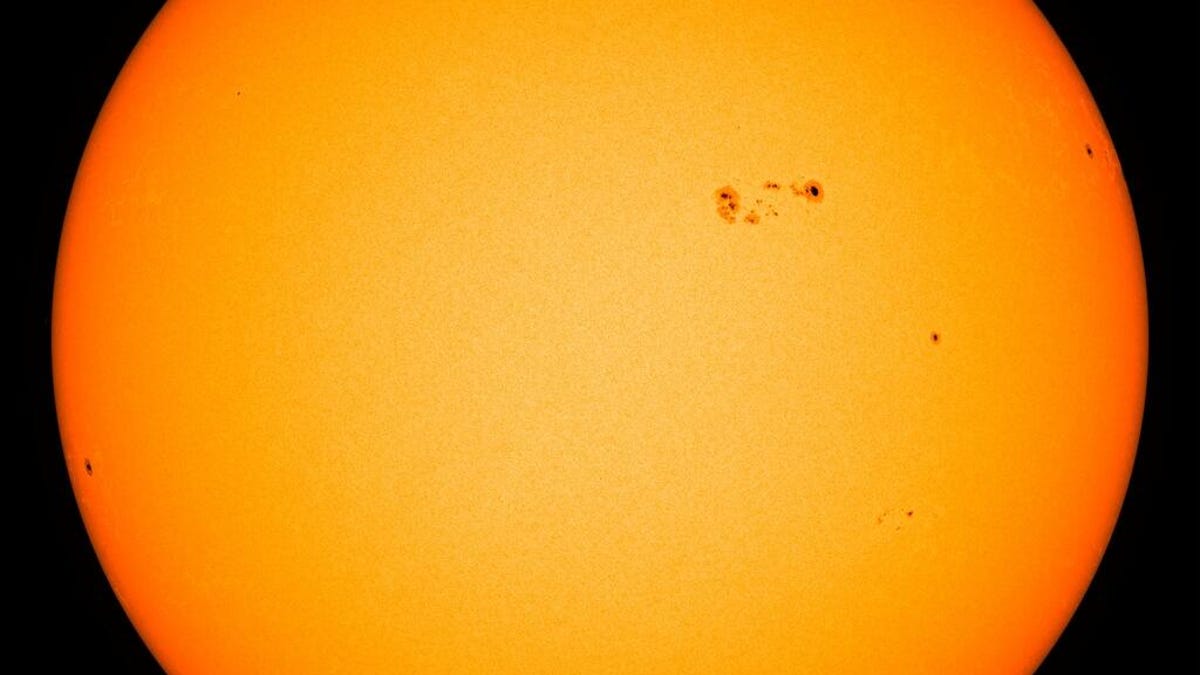A Massive Sunspot That Could Unleash Significant Solar Flares Is Pointed Right at Us

That dark area on the sun is as wide as several earths.
What's happening
A central sunspot has grown dramatically in the past few days.
Why it matters
Sunspots can throw off powerful solar flares that disrupt radio communications on Earth and sometimes impact the power grid.
Space weather watchers are keeping a close eye on a dark and volatile spot on the sun that's grown dramatically this week.
Between Sunday and Monday, Sunspot AR3038 more than doubled in size, making it several times wider than Earth's diameter, and it's continued to expand in the past 48 hours, according to NASA heliophysicist C. Alex Young, writing at EarthSky.
Sunspots are darkened, cooler areas on the sun's surface with unstable magnetic fields, and they can produce solar flares and coronal mass ejections of charged particles and plasma. These flares and ejections occasionally cause chaos for electrical and radio communications systems here on Earth.
Over the last day, the mega-sunspot has let off a pair of minor, C-class solar flares while pointing straight at Earth, but Astronomer Tony Phillips reports at Spaceweather.com that "Sunspot AR3038 has a 'beta-gamma' magnetic field that harbors energy for (medium strength) M-class solar flares."
A beautiful display by departing region AR3031. A C5.6 flare with post flare loops and some dynamic prominence activity. Gorgeously👏🌞🤩😆 shown with SDO 171 and 304. https://t.co/oi3ddL9M54
— Dr. C. Alex Young (@TheSunToday) June 22, 2022
Generally M-class flares aren't that big of a deal, but earlier this year, a flurry of M-class flare activity created a geomagnetic storm strong enough that SpaceX reported it had essentially fried a number of its Starlink satellites.
Our magnetosphere prevents the radioactive eruptions from harming life on the surface of Earth, but it does pose a risk to our communications systems, astronauts in space and even the electrical grid on the ground, particularly more powerful X-class flares.
The National Oceanic and Atmospheric Administration's Space Weather Prediction Center forecasts a 25 percent to 30 percent chance of M-class flares over the next three days and a 5 percent to 10 percent chance of X-class flares.
The first sunrise of the northern summer. Giant sunspot AR3038 is clearly visible.
— Domenico (@AvatarDomy2) June 22, 2022
Credit 📷 by Joseph Golebieski on June 21, 2022 Lavallette, NJ pic.twitter.com/orPhtsB2A9
Our star goes through regular periods of high sunspot and flare activity roughly every decade or so, a phenomenon known as the solar cycle. We're currently building toward a peak of activity that's expected to arrive near the middle of the 2020s, but 2022 has progressed ahead of schedule. This year has already seen some powerful X-flares, and sunspot activity in May was more than double what forecasters predicted.
Large-scale blackouts have been caused by flares in recent decades, and this is the first time we're approaching the peak of solar activity with thousands of new satellites in orbit.
On the positive side, all this action on the sun also boosts the odds of seeing some spectacular auroras, particularly at higher latitudes. We'll keep you posted if the chances of a dramatic light show suddenly escalate.

